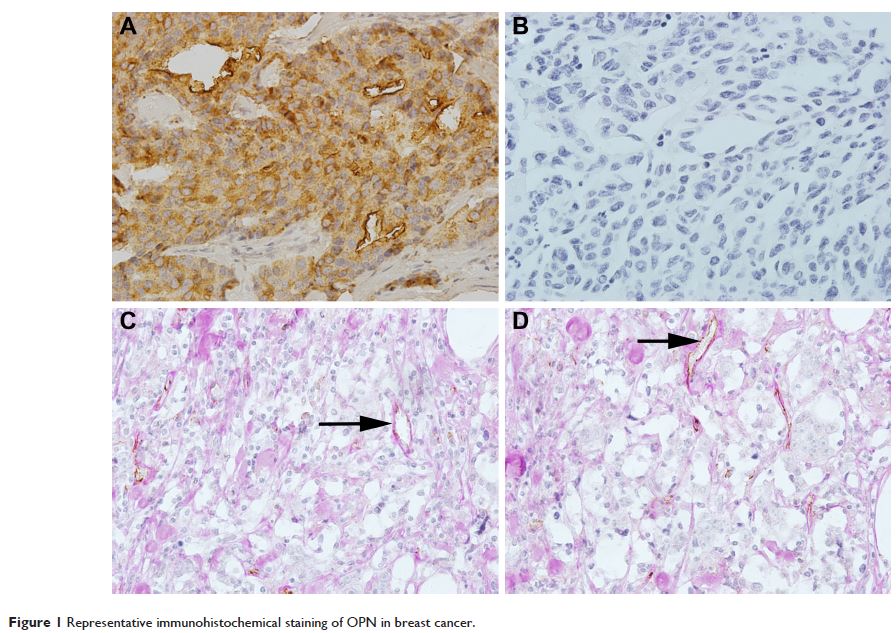9 0 8 0 2
论文已发表
注册即可获取德孚的最新动态
IF 收录期刊
- 2.6 Breast Cancer (Dove Med Press)
- 3.9 Clin Epidemiol
- 3.3 Cancer Manag Res
- 3.9 Infect Drug Resist
- 3.6 Clin Interv Aging
- 4.8 Drug Des Dev Ther
- 2.8 Int J Chronic Obstr
- 8.0 Int J Nanomed
- 2.3 Int J Women's Health
- 3.2 Neuropsych Dis Treat
- 4.0 OncoTargets Ther
- 2.2 Patient Prefer Adher
- 2.8 Ther Clin Risk Manag
- 2.7 J Pain Res
- 3.3 Diabet Metab Synd Ob
- 4.3 Psychol Res Behav Ma
- 3.4 Nat Sci Sleep
- 1.9 Pharmgenomics Pers Med
- 3.5 Risk Manag Healthc Policy
- 4.5 J Inflamm Res
- 2.3 Int J Gen Med
- 4.1 J Hepatocell Carcinoma
- 3.2 J Asthma Allergy
- 2.3 Clin Cosmet Investig Dermatol
- 3.3 J Multidiscip Healthc

骨桥蛋白 (Osteopontin) 和血管生成模拟模型与晚期乳腺癌新辅助化疗的反应有关
Authors Gu M, Zheng X
Received 5 December 2016
Accepted for publication 11 April 2017
Published 18 August 2017 Volume 2017:10 Pages 4121—4127
DOI https://doi.org/10.2147/OTT.S129414
Checked for plagiarism Yes
Review by Single-blind
Peer reviewers approved by Dr Akshita Wason
Peer reviewer comments 2
Editor who approved publication: Dr Yao Dai
Introduction: Osteopontin (OPN), a multifunctional phosphoprotein, has been
implicated in a series of important physiologic and pathophysiologic processes.
In breast cancer, OPN functionally contributes to the tumorigenicity of
spheroid-forming cells. It also plays a critical role in enhancing the
proliferation, tumorigenicity, and ability to display vasculogenic mimicry (VM)
of spheroid-forming cells in breast cancer. However, the role of OPN in breast
cancer is not clear.
Patients and methods: This study investigated OPN expression and VM in
breast cancer patients before neoadjuvant chemotherapy (NACT). Their
association with clinicopathologic factors was first analyzed by
immunohistochemistry. Then, the response of breast cancer patients to NACT was
evaluated. The correlation between the clinicopathologic factors, including the
molecular subtype, and the response to NACT was analyzed.
Results: Immunohistochemical analysis showed positive
staining of OPN in 40% of the breast cancer patients, whereas VM, which was
related to tumor stage, was observed in 30% of cases. OPN expression was found
to have a significant correlation with VM (P <0.05). The results
also indicated that the clinicopathologic factors were not related to the
response to NACT, including the molecular subtype. The multivariate analysis of
clinicopathologic features correlated with pathological complete response (pCR)
indicated that OPN(+)VM(+) was correlated with pCR (P <0.001).
Conclusion: Our findings underlined that the concurrence of
OPN-positive expression and VM can predict the pCR to NACT in breast cancer.
The efficiency of NACT in certain patients can be easily predicted by detecting
the expression of OPN and VM.
Keywords: osteopontin,
vasculogenic mimicry formation, breast cancer, neoadjuvant chemotherapy
